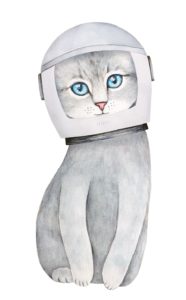Cats always get the short straw. Drug companies don’t invest as much time and money in cats as they do in dogs. Maybe they know that owners don’t bring them in for regular checkups like they do with their dogs.
Luckily, cats can’t measure straws and usually just knock them off the table and bat them around instead of pouting about this. And though there are not as many cutting-edge technologies designed for cats as there are for dogs, there are a few inventions out there intended to improve their quality of life.

The litter box is one area where cats have some fancy options. The Litter-Robot is an example of the evolution of litter boxes. It’s basically a spaceship that senses every time a cat enters. The box cleans itself by rotating around and filtering the litter. It’s great for humans, too, because it means you no longer scoop the box. But you do need to empty the drawer it dumps into pretty frequently. And it works only if your cat weighs at least five pounds.
These things being high-tech, upgrades are inevitable. The newer version connects to your smart phone and alerts you when the drawer is full — presumably making litter box care easier for people who have lost their sense of smell.
I suspect most cats will take to this robot quickly, because they prefer a pristine litter box, which is what this provides. It also makes cats think they are getting in a spaceship to return to the planet they came from.
The rule of thumb, by the way, is that you should have as many litter boxes as cats, plus one. So, one cat needs two litter boxes. It won’t be easy for ordinary people to afford enough of these, as they run between $300 and $500.
Another of my favorite technokat tools is feeders that open only for specific cats, after identifying them by their microchips or microchip-embedded collars. While it can take time to acclimate some cats to the movements and sounds of these feeders, they enable people who have multiple cats to provide the right foods for each — for example, if one cat needs prescription foods or another needs ration control for weight loss.
Many years ago, I tried a timed feeder for my cat. Soon, every animal in my house learned to be ready at the exact moment it would pop open. It was a great opportunity to watch interspecies cooperation. They would gather to get the 15 kibbles and then knock them around the house. This newer technology would have allowed the cats to dine privately, on their own schedules.
Dog DNA tests are a recent but already familiar product. Cats, of course, are not dogs. Cats were initially “tamed” (ha!) to carry out vermin control. Only recently were breeds based more on appearance than skills.
Dogs have a long history of being bred for certain tasks, like hunting, retrieving, herding, or, for a lucky bunch, sitting on laps. With cats, it seems fitting that while you can run a test that will tell you your cat’s ancestry and traits like coat color, you won’t learn much else. You might find out your cat is more likely from India than Europe, but you won’t learn all the hilarious breed combinations as you often do when you test your dog’s DNA. This is one of the reasons I love working with cats: you have to be ingenious to get them to tell you their secrets.
And, of course, we can’t discuss cat technologies without mentioning the Cat Scan. I don’t mean the diagnostic tool, but the scans that lead to scratched ankles from prematurely trying to get away from any given cat’s scan.
At least, that has been my experience living with a tiger cat from outer space or the Arabian Sea — I haven’t run a test yet — who insists on scanning my legs every day when I come home from work.
The Cat Scan is generally performed while giving its human the stink eye, signaling that the cat wonders where its dinner is and why its litter box has not been scooped yet.
Sadie Hutchings, D.V.M., practices at the Herring Cove Animal Hospital in Provincetown.



